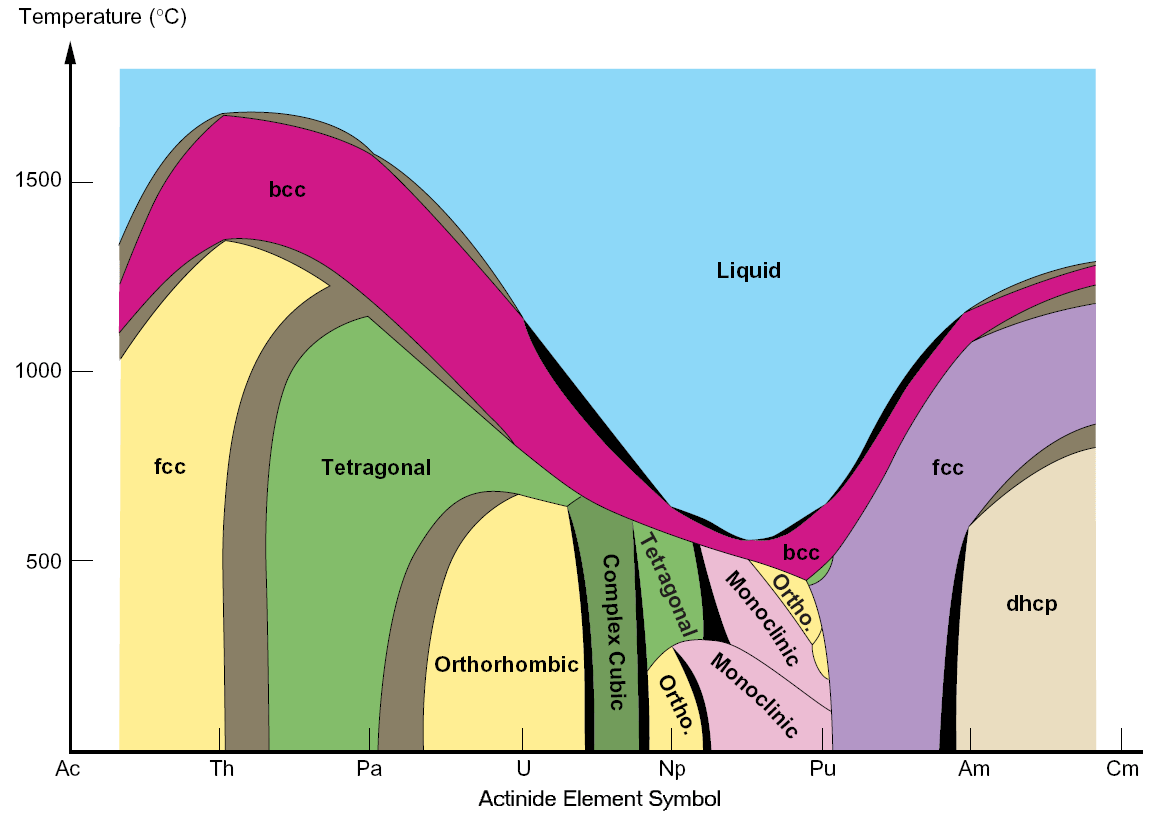Actinide
| Atomic No. | Name | Symbol |
|---|---|---|
| 89 | Actinium | Ac |
| 90 | Thorium | Th |
| 91 | Protactinium | Pa |
| 92 | Uranium | U |
| 93 | Neptunium | Np |
| 94 | Plutonium | Pu |
| 95 | Americium | Am |
| 96 | Curium | Cm |
| 97 | Berkelium | Bk |
| 98 | Californium | Cf |
| 99 | Einsteinium | Es |
| 100 | Fermium | Fm |
| 101 | Mendelevium | Md |
| 102 | Nobelium | No |
| 103 | Lawrencium | Lr |
The actinoid (according to IUPAC terminology) (previously actinide) series encompasses the 15 chemical elements that lie between actinium and lawrencium included on the periodic table, with atomic numbers 89 - 103.[1] [2] The actinoid series derives its name from the first element in the series, actinium, and ultimately from the Greek ακτις (aktis), "ray," reflecting the elements' radioactivity.
The actinoid series (An) is included in some definitions of the rare earth elements. IUPAC is currently recommending the name actinoid rather than actinide, as the suffix "-ide" generally indicates ions (moreover, from Latin, the suffix -ide means "sons of actinium", while -oid means "similar to actinium"). There are alternative arrangements of the periodic table that exclude actinium or lawrencium from appearing together with the other actinoids.
The actinoids display less similarity in their chemical properties than the lanthanoid series (Ln), exhibiting a wider range of oxidation states, which initially led to confusion as to whether actinium, thorium, and uranium should be considered d-block elements. All actinoids are radioactive.
Only thorium and uranium occur naturally in the earth's crust in anything more than trace quantities. Neptunium and plutonium have been known to show up naturally in trace amounts in uranium ores as a result of decay or bombardment. The remaining actinides were discovered in nuclear fallout, or were synthesized in particle colliders. The latter half of the series possess exceedingly short half-lives.
The actinoids are typically placed below the main body of the periodic table (below the lanthanoid series), in the manner of a footnote. The full-width version of the periodic table shows the position of the actinoids more clearly.
An organometallic compound of an actinoid is known as an organoactinoid.
History of the actinoid series
From the earlier known chemical properties of actinium (89) up to uranium (92), indicating a relation to the transition metals, it was generally assumed that the transuraniums would have similar qualities. During his Manhattan Project research in 1944, Glenn T. Seaborg experienced unexpected difficulty isolating americium (95) and curium (96). He began wondering if these elements more properly belonged to a different series than the transition metals, which would explain why the expected chemical properties of the new elements were different. In 1945, he went against the advice of colleagues and proposed the most significant change to Mendeleev's periodic table to have been accepted universally by the scientific community: the actinide series.
In 1945, Seaborg published his actinide concept of heavy element electronic structure, predicting that the actinides would form a transition series analogous to the rare earth series of lanthanoid elements.
In 1961, Antoni Przybylski discovered a star that contained unusually high amounts of actinides.

See also
References
External links
- The Columbia Encyclopedia, Sixth Edition.
- Chemical Elements website
- Actinides on the Book Rags website
- Lawrence Berkeley Laboratory image of historic periodic table by Seaborg showing actinide series for the first time
- Lawrence Livermore National Laboratory, Uncovering the Secrets of the Actinides
- Los Alamos National Laboratory, Actinide Research Quarterly
af:Aktinied ar:أكتينيدات ast:Actínidu bs:Aktinoidi ca:Actínid cs:Aktinoidy da:Actinid de:Actinoide et:Aktinoidid el:Ακτινίδες eo:Aktinoido fa:آکتینید gl:Actínidos ko:악티늄족 hr:Aktinoidi id:Aktinida is:Aktiníð it:Attinidi he:אקטיניד lt:Aktinoidai lmo:Atíniit ms:Aktinida nl:Actinide no:Aktinoider nn:Aktinid nds:Actinoid qu:Aktinyu rikch'aq q'illay simple:Actinide sk:Aktinoid sr:Актиноиди sh:Aktinoidi fi:Aktinoidi sv:Aktinoider th:แอกทิไนด์ uk:Актиноїди